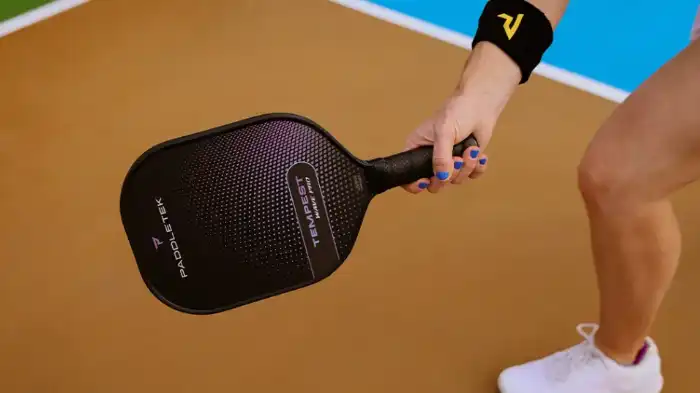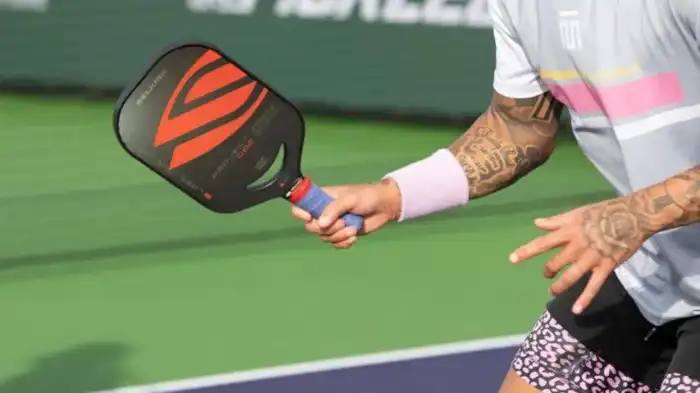When it comes to playing pickleball, a proper grip is one of the essential elements for success. Among the various grips used in this fast-paced sport, the continental grip stands out as a versatile and effective choice. In this blog, we will explore What is the Continental Grip in Pickleball? Its advantages, and how to execute it correctly to enhance your pickleball skills.
What is the continental grip in pickleball?

The continental grip is a grip commonly used in tennis that has found its way into pickleball. It involves holding the paddle in such a way that the base knuckle of your index finger (the knuckle closest to your palm) is placed on the right bevel (for right-handed players) or the left bevel (for left-handed players) of the paddle handle. This placement creates an angle with the paddle face and allows you to maneuver the ball effectively in various situations.
The Advantages of the Continental Grip
The continental grip offers several advantages that make it a popular choice among pickleball players:
1. Increased Control
By using the continental grip, players can achieve better control over the ball. This grip minimizes the chances of paddle twisting upon contact, allowing for more accurate and precise shots. It provides a stable hold on the paddle, enhancing your ability to guide the ball with greater control.
2. Versatility
One of the main reasons the continental grip is favoured by many pickleball players is its versatility. This grip allows for different shot types, including dinks, volleys, serves, and ground strokes. Regardless of the technique you use, the continental grip can adapt to your style and support a wide range of shots, making it highly adaptable in various game scenarios.
How to Execute the Continental Grip?
Here are the steps to properly execute the continental grip:
1. Start with a Neutral Grip
Hold the paddle handle with a neutral grip aligned with your forearm. Your knuckles should be positioned towards the sky.
2. Rotate the Paddle
Rotate the paddle in your hand counterclockwise until the base knuckle of your index finger rests on the desired bevel. Ensure a firm grip without excessive tension.

3. Adjust Paddle Angle
Angle the face of the paddle slightly towards the net to allow for better control and maneuverability during shots.
4. Practice and Familiarize
Practice holding the continental grip and try it out in different pickleball situations to become comfortable and familiar with this grip style. Experiment with shot variations and note how the continental grip impacts your control and shot execution.
Conclusion
What is the Continental Grip in Pickleball? The continental grip serves as an invaluable tool in the skillset of a pickleball player. Its ability to provide enhanced control, versatility, and support for various shots makes it an excellent choice for players looking to take their game to the next level. By mastering the continental grip and incorporating it into your gameplay, you’ll undoubtedly notice improvements in your accuracy and overall performance on the pickleball court.
Frequently Asked Questions
The continental grip is a hand position used in pickleball where the paddle handle is held diagonally across the palm, with the base knuckle of the index finger on the top bevel of the paddle.
The continental grip is versatile and allows players to easily switch between different shots, including forehand drives, backhand shots, volleys, and serves. It provides better control, accuracy, and power while minimizing the risk of hitting mishits.
To hold the paddle in a continental grip, rest the handle diagonally across your palm so that the base knuckle of your index finger touches the top bevel. Wrap the remaining fingers around the handle, ensuring a secure and comfortable grip.
Yes, the continental grip is suitable for players of all skill levels in pickleball. Beginner players often find it easier to learn and adapt to this grip because of its simplicity. Seasoned players also rely on the continental grip for its versatility and effectiveness in different situations during the game.
Yes, apart from the continental grip, players can also use the eastern grip and the western grip. However, these grips are less commonly used compared to the continental grip. The eastern grip is similar to a tennis grip and is mainly used for forehand shots, while the western grip is rarely utilized and offers limited maneuverability.

